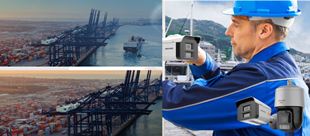13/12/2013
Strengthening loss prevention with modern unified security solutions
This is why more and more retailers are considering the benefits of network security technology to enhance their loss prevention strategy. They are turning to newer concepts and modern security solutions that will help them not only contend with shrinkage, but also achieve operational efficiencies and gather business intelligence from store activity.
Shrink-minimizing with unification
Unifying multiple security solutions under a single platform is becoming a prevalent trend in retail loss prevention, helping to minimize losses all while providing a new source of marketing information. Implementing a unified security platform helps to seamlessly merge video surveillance, access control, and license plate recognition with other retail systems in one efficient and userfriendly solution. A unified platform takes efficiency a step further by consolidating and standardising the common aspects of security operations such as real-time event and video monitoring, advanced reporting, alarm management and configuration, and make all tasks easily accessible via an intuitive client application.
Future proof open architecture
Retailers considering a move to unification should look at the security platform with an open architecture. The flexibility of an open architecture helps retailers lower their total cost of ownership by keeping existing hardware investments, or slowly migrating to new technology at their own pace. Retailers can also consider adding a few HDTV network cameras to achieve a minimum of three times the resolution of the same analogue cameras for more sensitive areas like cash registers or receiving doors. Improved video quality helps operators to better track and identify instances of shrinkage or fraud.
Unifying POS data with video
The concept of open architecture also extends to unification. Data and information from external systems such as POS, EAS, access control, video analytics or intrusion systems can be seamlessly integrated within a unified platform, offering retailers a powerful tool for investigations. For example, some platforms offer intricate search functionality where an investigator could ask the system to display the video of all stores when a receiving door was opened say after 4:00 pm, or to show all refunds from that day's transactions over a certain dollar value. The associated video can then be instantly reviewed.
In cases of franchises or multiple locations, retailers should consider the central management capabilities of a unified platform. Providing each store's security team to independently manage their facility's security while also tying all systems back to headquarters for centralised event and video monitoring can be vital to operations. This could lead to significant savings by not requiring security personnel at each store during off-peak hours for example. Looking at platforms that also do not restrict size or geographic limitations where hundreds or thousands of retail locations can be spread across several regions and countries is equally important for future growth plans.
Remote and mobile access
Another inherent benefit of choosing an advanced IP-based security platform is the ability to gain access to live or recorded video from any network location, including via mobile devices. A mobility feature becomes beneficial to the store owner who needs to check-in on his business from home, or the security guard who is on the floor and needs to respond to an alarm. But remote video access can also aid the business in being more responsive to the need for change. For example, enabling merchandising departments to remotely audit store compliance with a promotion or end cap display and instantly correct display guidelines that have not been adhered to.
Retailers can also choose from the latest IP megapixel cameras to capture clearly detailed, high resolution video to view incidents and identify suspects. Then retailers can get access to an easy-to-use online management platform that lets them view live and recorded video from their laptop, tablet or smartphone. Most cloudhosted video surveillance provides advanced functionality to handle alarms, bookmark clips, save video to permanent storage, share or even export video to their computer. This offers retailers with peace of mind, knowing that their business is safe, and operations are running smoothly, from anywhere.
The right technology
Enhancing a loss prevention strategy means adopting the right technology for the job. A unified security platform and a cloud-based video management solution are two cutting-edge options available to retailers today. Not only do their powerful features and capabilities help loss prevention teams become more effective at pinpointing theft, and closing cases, but also help extend operational efficiencies to other departments. And combined, this is precisely how the right investment in security technology can positively impact any retailer's bottom line.

















